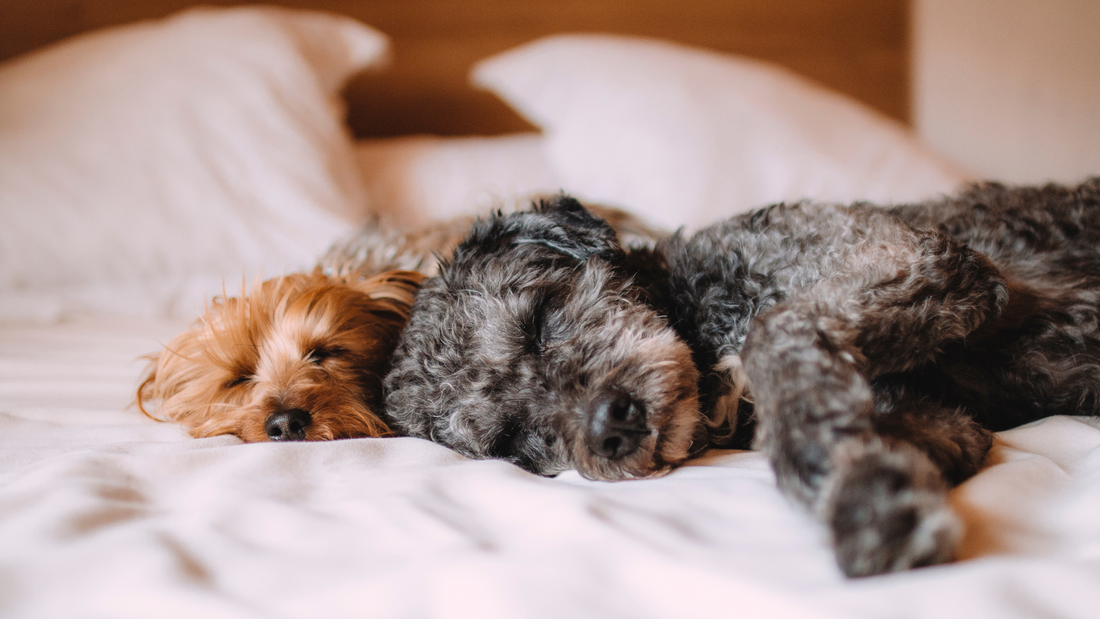A Fast & Easy Calming Strategy
When your dog is anxious, their nervous system is on high alert. Instead of waiting for them to "calm down," use this quick, 3-step method to help them feel safe fast.
Understanding Prolonged Anxiety in Dogs
Dogs experience anxiety for many reasons, but when stress becomes prolonged, it can impact their physical and emotional healt (and yours too!)
- Left untreated, chronic anxiety can lead to
-
Destructive behaviors (chewing, digging, excessive barking
-
Reduced quality of life (fear-based avoidance, inability to relax
- Health issues (digestive upset, immune suppression, skin problems)
Common Causes of Long-Term Anxiety in Dogs
- Separation Anxiety – When a dog becomes overly stressed when left alone.
- Noise Sensitivity – Fear of thunderstorms, fireworks, or loud sounds.
- Changes in Routine – Moving homes, a new pet, or changes in family structure.
- Lack of Socialization – Fear of new people, places, or other dogs.
- Past Trauma – Rescue dogs or those with a history of abuse may have lingering stress triggers.
If a dog is experiencing ongoing anxiety, intervention is key. The faster you address stress, the easier it is to help them feel safe again.
Symptoms of Anxiety in Dogs
If your dog shows any of these frequent behaviors, they may be struggling with anxiety:
- Excessive Barking or Whining – Vocalizing often, especially when left alone.
- Panting & Pacing – Restlessness, even when there’s no reason.
- Destructive Behavior – Chewing furniture, digging, or shredding objects.
- Hiding or Avoidance – Retreating under furniture or avoiding eye contact.
- Shaking or Trembling – Uncontrollable trembling in safe environments.
- Aggression or Reactivity – Growling, snapping, or fear-based biting.
- Loss of Appetite or Digestive Issues – Stress-related tummy troubles.
- Excessive Licking or Chewing Paws – Self-soothing that can lead to sores.
If you notice multiple symptoms regularly, it's time to take action. Start here:
The 3-Minute Anxiety Fix for Dogs
Now that you understand why anxiety happens, here’s a quick way to reduce stress fast and help your dog feel safe.
The Deep Breath & Whisper Technique (1 Minute)
Dogs mirror your energy—if you’re tense, they stay tense. Try this:
- Take three deep breaths near your dog.
- Lower your voice and whisper calmly—dogs respond better to soft tones.
-
Say slow, reassuring phrases, like:
- "You're safe."
- "I've got you."
-
"Good job, buddy."
- Place one hand on their chest or shoulders for gentle grounding. (The chest or shoulders NOT THE TOP OF THE HEAD is a "safe" place to touch)
Why It Works: This helps slow your dog’s breathing and redirects their focus from stress to safety.
The “Calm Mat” Training Method (2-3 Minutes)
Teaching your dog to settle on a mat or blanket can create a predictable safe space they associate with relaxation.
How to Use the Calm Mat Method:
- Pick a dedicated “calm mat”—a small rug, towel, or blanket your dog can use anywhere.
- Place the mat in a quiet area where your dog naturally likes to rest.
- Encourage them to lie down on the mat and reward them with soft praise or a favorite treat.
- Add a cue word, like “Relax” or “Settle”, whenever they lie down on it.
- Gradually increase the time they spend on the mat while staying calm.
Why It Works: Dogs feel safer when they have a designated “chill zone”—just like humans relax in their favorite chair. Over time, your dog will associate the mat with calmness, helping them self-soothe during anxious moments.
How to Use the Calm Mat for Anxiety Relief:
Before a stress event: Encourage your dog to settle on the mat 5-10 minutes before you leave the house or before a thunderstorm starts.
During stressful moments: If your dog is anxious, redirect them to their mat with a calm voice and a treat.
As a daily practice: Regular use builds their ability to relax on cue, making anxiety triggers easier to handle.
The ‘Reset & Redirect’ Walk (1-2 Minutes)
Movement + sensory engagement helps dogs process stress faster than sitting still.
- If indoors: Guide your dog through a slow, controlled "reset" walk in a small circle or to a different room
- If outdoors: Take a 1-2 minute sniff walk—letting your dog explore new scents naturally lowers stress hormones.
- Reward small relaxations like a deep sigh, a tail wag, or sitting calmly.
Why It Works: Movement releases stress energy, helping your dog shift out of "fight-or-flight" mode.
When used together, these fast, simple steps help your dog feel safe and supported in minutes.
Bonus! Try Completely Calm for Even Faster Relief
Want an easy, natural way to help your dog feel calm and secure?
The Calming Chew Boost (30 Seconds)
For faster relief, support your dog’s nervous system from the inside out.
- Give your dog a Completely Calm chew—a natural, fast-acting treat designed to soothe anxiety.
- Works in 30 minutes or less, so it’s great for fireworks, separation, travel, and stress triggers.
- Ingredients like Chamomile, Lions Mane, L-Theanine & Valerian Root help ease tension without drowsiness.
Why It Works: Helps balance stress hormones, making it easier for your dog to relax naturally.
Completely Calm is a fast-acting, all-natural chew designed for 7 types of anxiety:
- Separation Anxiety: Separation anxiety is an emotional anxiety that happens when dogs become distressed in the absence of their owners. Your dog misses you when you’re gone and worries that something happened to you. Symptoms include excessive barking or howling, destructive behavior (chewing, ripping things like papers or digging), and house soiling.
-
Noise Anxiety: Loud noises such as thunderstorms, fireworks, and even household appliances can trigger anxiety in dogs. For some dogs, even the clicker in obedience training can cause stress. When noise is an issue, your dog may exhibit signs like trembling, shaking, hiding, or trying to escape.
- Social Anxiety: Just like people, some dogs become anxious in social situations, whether it’s meeting new people, other dogs, or being in unfamiliar environments. To feel better, a dog experiencing social anxiety might have aggressive behavior such as lunging, excessive barking, or withdrawing and running away.
-
Travel Anxiety: A simple trip in the car for a short ride or a longer trip can cause anxiety in some dogs. While they may start by jumping in the car eagerly, as anxiety sets in your scared pup might start panting, drooling, vomiting, or restless pacing.
- Rescue Anxiety: Doing a great thing like rescuing your new dog can lead to unexpected anxious behavior. Your dog many have experienced abandonment or other trauma and will need some time to adjust.
- Illness Induced Anxiety: Underlying health conditions such as arthritis or digestive problems can make dogs anxious and reluctant to interact with others. When a dog doesn't feel good but is forced to play, eat or talk a walk when they hurt can result in fear of hurting even more.
- Generalized Anxiety: Some dogs may have a more chronic form of anxiety, which is less specific but can cause persistent nervousness and fear in various situations. Like humans, dogs can be afraid of EVERYTHING - new treats, different smells, wind or even the pressure of changing weather can create a loss of appetite, licking or grooming themselves to excess. Unless they are having an allergic reaction, these symptoms are not normal.
Try Completely Calm today and give your dog the peace they deserve!
Want More Quick-Fix Anxiety Tips for You AND your dog?
Get anxiety relief (with a little humor) straight to your inbox! Sign up for free: www.StressLessWagMore.com

